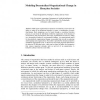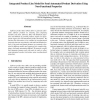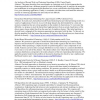954 search results - page 20 / 191 » Principles and Models for Organizing the IT Function |
ECAL
2007
Springer
14 years 1 months ago
2007
Springer
Multi-agent organizations in dynamic environments, need to have the ability to adapt to environmental changes to ensure a continuation of proper functioning. Such adaptations can b...
VAMOS
2008
Springer
13 years 9 months ago
2008
Springer
Software product lines (SPLs) allow to generate tailormade software products by selecting and composing reusable code units. However, SPLs with hundreds of features and millions o...
IJCNN
2000
IEEE
13 years 12 months ago
2000
IEEE
eresting web-available abstracts and papers on clustering: An Analysis of Recent Work on Clustering Algorithms (1999), Daniel Fasulo : This paper describes four recent papers on cl...
ACL
1998
13 years 9 months ago
1998
This paper proposes a learning method of translation rules from parallel corpora. This method applies the maximum entropy principle to a probabilistic model of translation rules. ...
TON
2010
13 years 2 months ago
2010
This paper presents "Self-Chord," a peer-to-peer (P2P) system that inherits the ability of Chord-like structured systems for the construction and maintenance of an overla...



